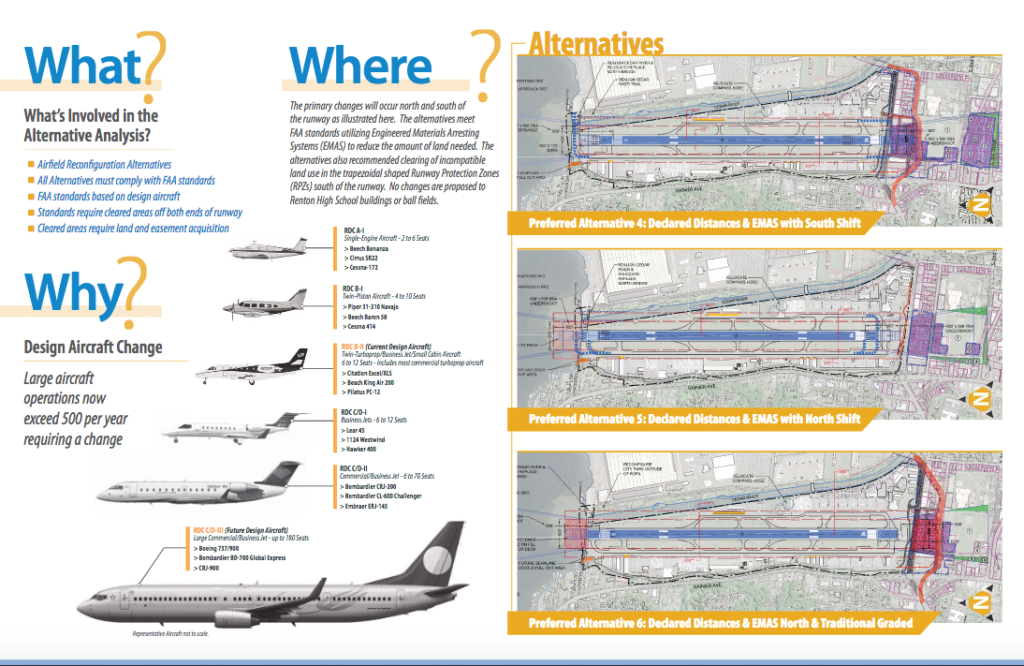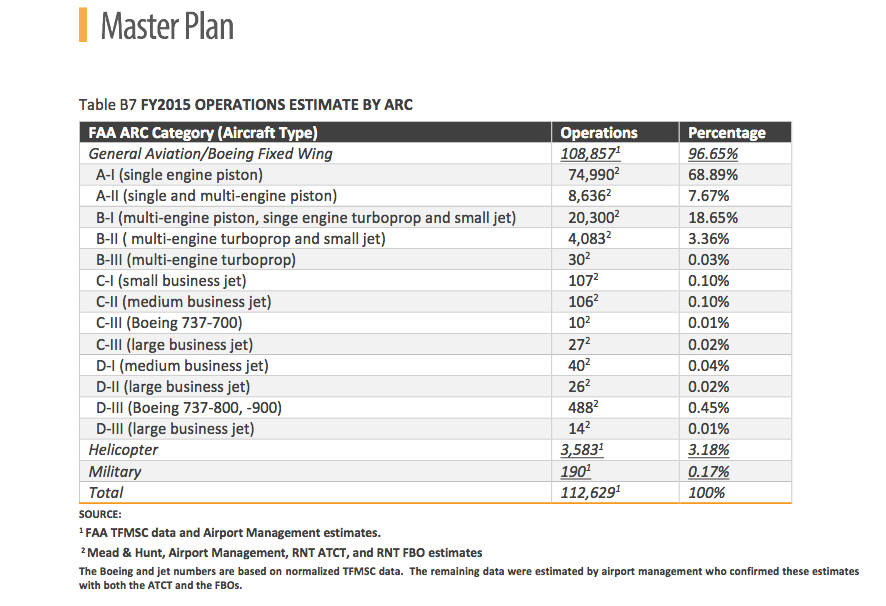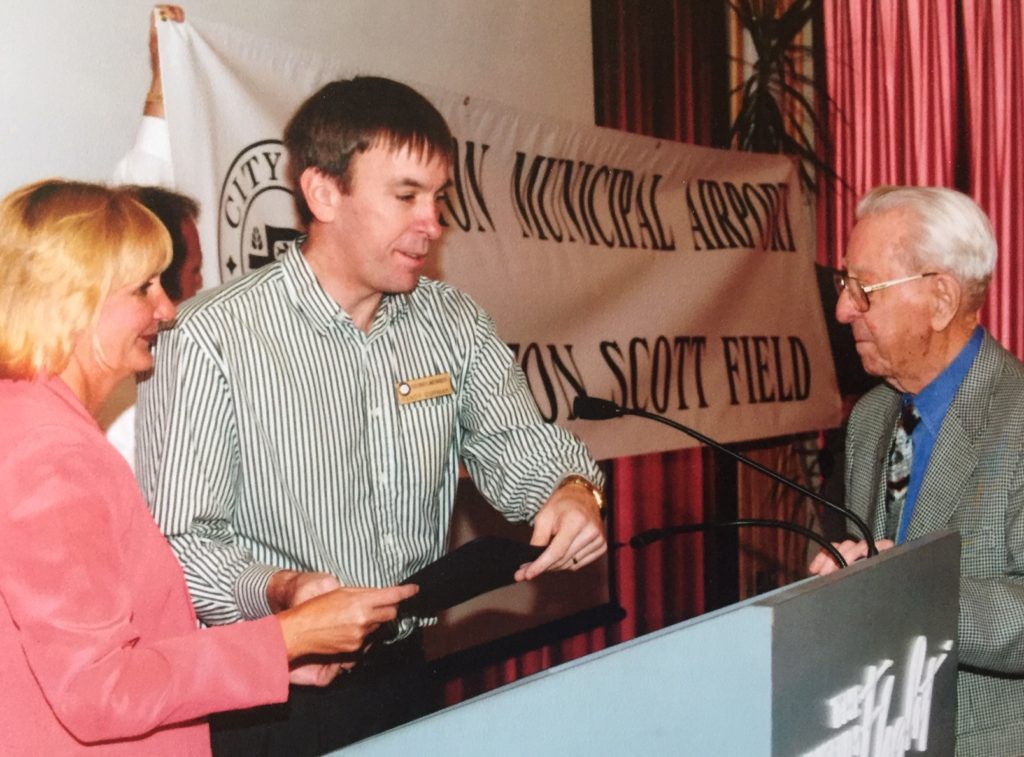Author’s note 4/8/2024: The Master Plan Update and Runway length extension described in this blog entry were not implemented (as of this update.) In the months after I wrote this entry, our aviation community and Renton leadership hired and aviation attorney and pushed back on the runway extension proposal. Then the pandemic began and reduced air traffic world-wide, including in Renton. The lower traffic no longer merited a debate about runway length extension. There was a seperate update to the Airport Layout Plan (a companion document that does not alter the runway) completed in 2022.
In this blog entry I describe critical issues at Renton Airport that must be resolved carefully to avoid negatively impacting the future of the airport and our city. 6.2 billion dollars a year in revenue, historic homes and neighborhoods, and thousands of jobs could all be impacted in various ways if the current Master Plan process is not sensitive to the needs of our unique airport and our community. I suggest we carefully re-review the underlying assumptions made by the airport consultants that are causing so much impact, in collaboration with FAA, airport businesses, neighborhoods, and other stakeholders.
In particular, we should focus on the assumption that 737s are the “critical aircraft” for purposes of sizing the airport safety zones, since 737s takeoff from Renton but rarely land here. (Landings are more hazardous than takeoffs and need greater safety margins.) Furthermore, when 737s do takeoff from Renton they are brand new, recently tested, and lightly loaded. We delivered even larger 757s safely and routinely from this airport for two decades, and never had any issues. Smaller aircraft that are engaged in normal operation at Renton would be more appropriate to size the airport runway and safety zones. The FAA Advisory Circulars allow for some leeway, and we should utilize it to protect our community and businesses.
Renton’s airport is important and historic:
The Renton Municipal Airport, Clayton Scott Field, is estimated to support 6.2 billion dollars a year in economic impact, including 18,000 jobs tied directly to airport businesses. Aviation provides over a third of all Renton jobs and indirectly creating many of our other jobs. Along with living-wage paychecks, our aviation businesses pay about 38 million a year in taxes which help keep our city and schools succeeding.
Our Airport is also an important part of history. In 1922 it was as a small turf runway called Bryn Mawr Airport. In 1935, two American icons, humorist Will Rogers and famed-aviator Wiley Post left the continental United States for the last time from Renton on their ill-fated trip to the Alaska frontier, Our Seaplane base now bares their names. In 1943 Renton airfield was expanded and modernized by the US government to build the Boeing B-29 Superfortress. In 1954, our airport ushered in the jet age in commercial passenger transportation by launching the Boeing Dash 80 followed by the 707. Also in 1954 local aviation pioneer Clayton Scott opened a business at Renton Airport alongside many other important businesses at the field. ” Scotty” had flown out of Renton in 1928, served as Boeing founder William Boeing’s personal pilot, was the first pilot to land at Boeing Field, and ultimately became chief test pilot for the Boeing Company. In 2006 Scotty flew himself to the Museum of Flight for a ceremony in which Marcie Palmer and I presented him with a banner naming the field after him. From 1965 until now Clayton Scott Field has been the home of the 737, the best selling airliner in history.
The current challenge:
The Renton Airport is undergoing a Master Planning process in order to maintain its safety, viability, and eligibility for Federal funding. Our consultants on the project have identified an updated designation and new safety zones and clearances consistent with the most recent FAA Advisory Circulars for new airport design. Unfortunately, these safety zones require us to extend the length of the airport by nearly 2000 feet, which either pushes it into the lake or right into downtown Renton. The added airport length has already created great concern in the community, as we would have to acquire anywhere from 40 to 100 new properties, including the sports field at Renton High School, and do work in the lake and Cedar River that may not be allowed due to environmental concerns. The airport could go all the way to Second Street. Comments from concerned citizens and businesses continue to come into city hall, and it is clear that the project is facing severe headwinds.
Then the other shoe dropped at the recent June 25th meeting of the Renton Airport Advisory Committee (RAAC), a committee of airport operators and representatives from Renton neighborhoods. As the consultants presented the impact of the larger proposed runway safety zones and runway object free area (where only frangible navigation aids can be located), it became apparent to airport businesses that seemingly every operation on the airport would be severely impacted by the changes. For instance, many hangers would have to be removed or downsized, the number of airplane tie-downs and Boeing airliner production stalls would be reduced, and the Seaplane dock would need to be reconfigured in a way that Seaplane pilots say will not support their operations. They only way to recover the space would be to somehow carve even more property out of surrounding airport neighborhoods.
The next proposed step of the Master Plan process was for the RAAC to choose the “preferred alternative” from the various extraordinary impacts to the airport, essentially pitting operations on the east side of the runway against operations on the west side of the runway.
In my view, going further down this path will drive wedges between individual airport businesses, and between the airport and nearby neighborhoods. We’re asking the RAAC to make a “Sophie’s choice” about which critical and historic airport businesses they wish to keep. The airport operators in turn wonder whether they need even more property from our historic downtown. We have enjoyed a period of relatively peaceful co-existence of our airport operations and the community during the past decade thanks to the RAAC, and this peace is in jeopardy due to the direction this master plan has taken.
A possible solution:
I feel the Master Plan process is off-track because of an incorrect conclusion regarding the future Airport Reference Code (ARC) designation of our airport. This designation has led to the increase in proposed safety zones causing uncertainty and turmoil.
The designation is reached by identifying the “critical aircraft,” per Advisory Circular 150-5000-17. This Advisory Circular, like all Advisory Circulars, is not law, but is one approach (often the preferred one) that the FAA will recognize as an acceptable method of achieving safety and compliance.
Per the Advisory Circular, “the critical aircraft is the most demanding aircraft type, or grouping of aircraft with similar characteristics, that make regular use of the airport. Regular use is 500 annual operations,including both itinerant and local operations but excluding touch-and-go operations. An operation is either a takeoff or landing.”
The Master Plan forecast looks at future Boeing deliveries, and concludes that the 737-900 size aircraft is going to be delivering at rates higher than 500 annual operations per year. It then concludes that this increase in 737 operations should push the Airport up to the higher level requirements of Airport Reference Code D-III, necessitating many of the controversial changes in safety zones. But note that all other airports have an equal number of 737 takeoffs and landings, and that landings are significantly more hazardous than takeoffs. Renton airport is unique in the nation in that virtually all 737 operations are take-offs. Furthermore, they are brand-new, recently-tested, lightly-loaded airplanes. Likewise, the 757, which is an even larger airplane capable of triggering a ARC D-IV category, delivered safely and routinely out of Renton airport for two decades with no issues. This is because the airport was not handling 757 landings, just take-offs. Hence, there is a strong argument to be made that the FAA Advisory Material is not a perfect fit for the Renton airport.
The “critical aircraft” decision comes into play in other FAA guidance, including Advisory Circular AC 150-5300-13A change 1. This Advisory Circular defines airport safety design guidance based on the identifed “critical aircraft.” FAA has excellent engineers, and this Advisory Circular guidance is outstanding for development of new airfields. But FAA acknowledges the Advisory Circular guidance may not always work for existing airports. Here are some important quotes from this advisory circular:
“The FAA recommends the standards and recommendations in this AC for use in the design of civil airports. In general, use of this AC is not mandatory. The standards and recommendations contained in this AC may be used by certificated airports to satisfy specific requirements of Title 14 Code of Federal Regulations (CFR) Part 139, Certification of Airports, subparts C (Airport Certification Manual) and D (Operations).”
“c. Existing airports. Every effort should be made to bring an airport up to current standards. It may not, however, be feasible to meet all current standards at existing airports, … For non-standard conditions associated. AC 150/5300-13A9/28/20122 with such projects, the FAA may consider alternative means of ensuring an acceptable level of safety. “
AC 150-5300-13A change 1 includes many important standards like runway separation from taxiways, that are important design practice for new airports. For instance, these standards ensure that if the “critical aircraft” is landing at the airport, while other aircraft of the same type are in a take-off queue on the taxiway, there is insignificant chance of the aircraft interfering with one another. Situations like this certainly apply to smaller aircraft like Cessnas at Renton airport, but would not apply to 737s which do not enter a take-off queue since they are not in commercial service out of Renton.
In Conclusion, before we turn our beloved and successful Renton Airport Advisory Committee into a battleground or we permanently hurt our airport, we need to thoroughly review whether we can choose another aircraft than the 737 as our critical aircraft. Or, we should formally apply to the FAA for appropriate and safe modifications to the standards for the reasons I’ve outlined above. Doing so will preserve a safe and viable airport that retains our critical businesses while respecting the surrounding community.
I worked professionally as an aircraft design engineer and manager for 33 years, meeting often with FAA and International Civil Aviation organizations to certify airliners and their operation. I’ve also served as Renton City Council member for 25 years and frequent Chair of Transportation Committee, helping oversee our Renton airport.
From the history files: Council Members Randy Corman and Marcie Palmer present a banner and resolution to Clayton Scott on his 100th birthday in 2006, officially naming the airfield at Renton Municipal Airport in his honor.





Wow, excellent summary of a very complex issue our Renton Airport & RAAC (Renton Airport Advisory Committee, established in 2001 by Mayor Tanner) are facing. Thank you Randy for this thoughtful post, & thank you for attending RAAC meetings.
Marcie Palmer, RAAC Member since May 2001